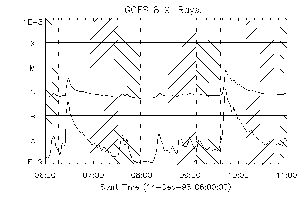
Two nicely almost-homologous compact flares occurred on Dec. 14, and
this science nugget describes them. These did not show ejecta. First take
a look at the time line, via GOES:

Here the stippling shows the timing of flare mode (the Al12 full-resolution images), and the diagonal lines show as usual the orbit night and SAA regions. Yohkoh and SXT worked perfectly, as we've come to expect, with ARS, AEC, and even with timely flare-mode triggers!
And here are images:

showing the first and last flare-mode images for each event. The homologous tendency is clear, but in the impulsive phases (actually three of them, because the rightmost image shows another compact brightening) one can see that the illuminated structure may or may not be the same physical item - certainly the locations are similar, however.
The associated gradual bursts seem much more similar, however. The overlaid contour diagrams below (06:35:45 UT in yellow; 10:02:27 UT in green) match almost exactly. The overlay corrects for solar rotation, about 8 pixels. The displacement (perhaps one SXT pixel, 2.46") needs to be measured more carefully - coalignment here has been done with the quick-look databases and may improve, and in any case the conclusions depend completely on the coalignment accuracy for a study of this type. But even so, it seems likely that the same field structure brightened up in each of the flares.

What conclusions might we eventually want to draw?